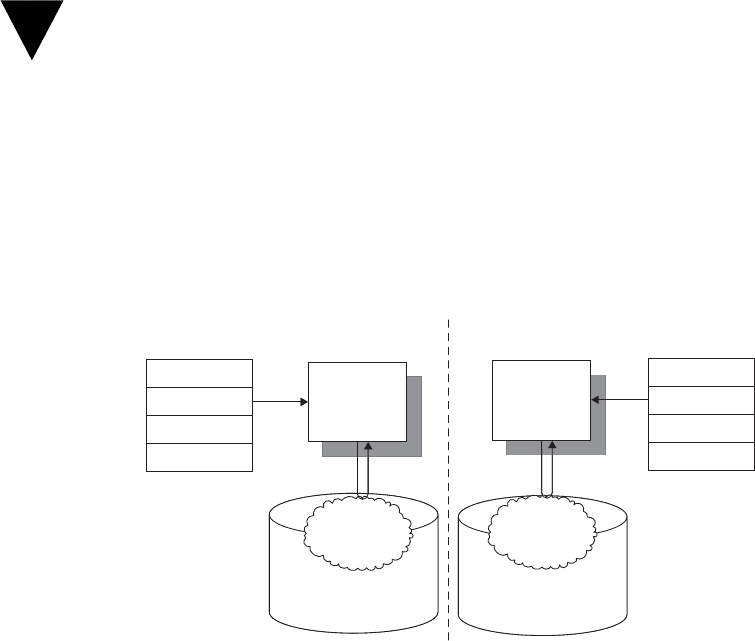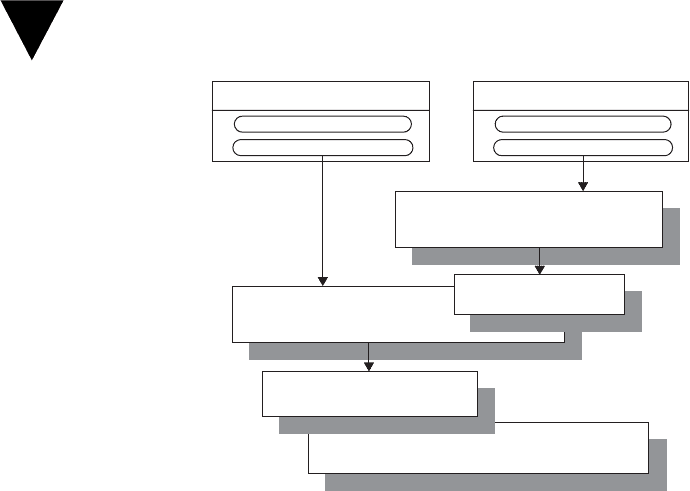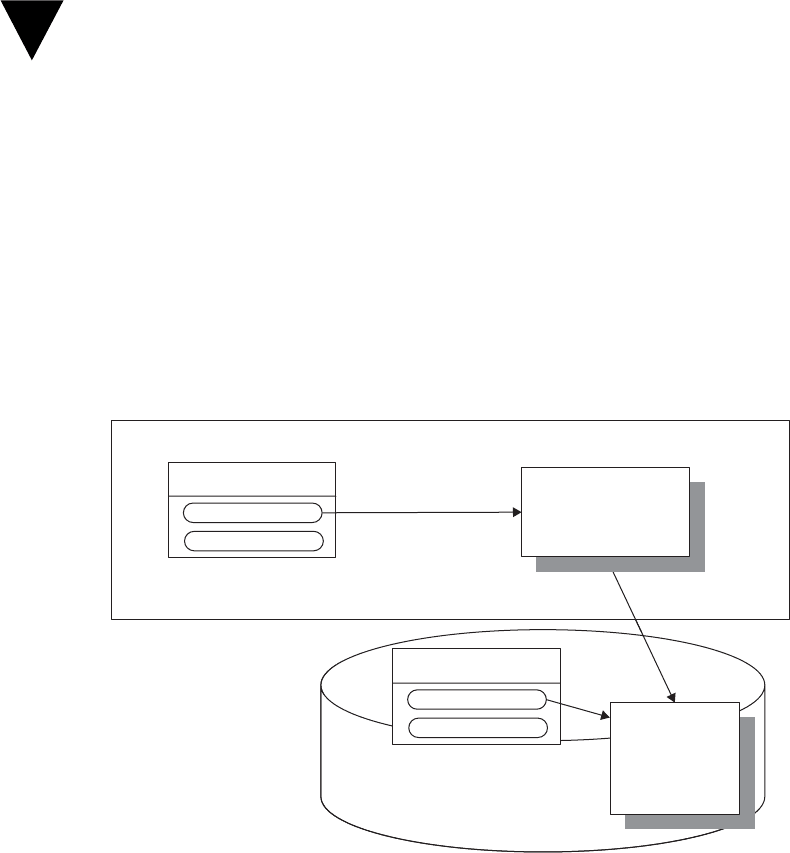Meszaros G. xUnit Test Patterns Refactoring Test Code
Подождите немного. Документ загружается.


168
Chapter 13 Testing with Databases
Why Test with Databases?
Many applications include a database to persist objects or data into longer-term
storage. The database is a necessary part of the application, so verifying that the
database is used properly is a necessary part of building the application. Therefore,
the use of a Database Sandbox (page 650) to isolate developers and testers from
production (and each other) is a fundamental practice on almost every project
(Figure 13.1).
Figure 13.1 A Database Sandbox for each developer. Sharing a Database
Sandbox among developers is false economy. Would you make a plumber and
an electrician work in the same wall at the same time?
Issues with Databases
A database introduces a number of issues that complicate test automation. Many
of these issues relate to the fact that the fi xture is persistent. These issues were
introduced in Chapter 9, Persistent Fixture Management, and are summarized
briefl y here.
Persistent Fixtures
Applications with databases present some special challenges when we are
writing automated tests. Databases are much slower than the processors used
in modern computers. As a consequence, tests that interact with a database
tend to run much more slowly than tests that can run entirely in memory. But
even ignoring the Slow Tests issue, databases are a prime source of test smells
in our automated test suites. Commonly encountered smells include Erratic
SUT
Setup
Exercise
Verify
Teardown
Database
Fixture
Developer 1
Database
SUT
Setup
Exercise
Verify
Teardown
Fixture
Developer 2
SUT
Setup
Exercise
Verify
Teardown
Database
Fixture
Developer 1
Database
SUT
Setup
Exercise
Verify
Teardown
Fixture
Developer 2

169
Tests (page 228) and Obscure Tests (page 186). Because the data in a database
may potentially persist long after we run our test, we must pay special atten-
tion to this data to avoid creating tests that can be run only once or tests that
interact with one another. These Unrepeatable Tests (see Erratic Test) and
Interacting Tests (see Erratic Test) are a direct consequence of the persistence
of the test fi xture and can result in more expensive maintenance of our tests as
the application evolves.
Shared Fixtures
Persistence of the fi xture is one thing; choosing to share it is another. Deliberate
sharing of the fi xture can result in Lonely Tests (see Erratic Test) if some tests
depend on other tests to set up the fi xture for them—a situation called Chained
Tests (page 454). If we haven’t provided each developer with his or her own
Database Sandbox, we might spark a Test Run War (see Erratic Test) between
developers. This problem arises when the tests being run from two or more Test
Runners (page 377) interact by virtue of their accessing the same fi xture objects
in the shared database instance. Each of these behavior smells is a direct conse-
quence of the decision to share the test fi xture. The degree of persistence and the
scope of fi xture sharing directly affect the presence or absence of these smells.
General Fixtures
Another problem with tests that rely on databases is that databases tend to evolve
into a large General Fixture (see Obscure Test) that many tests use for different pur-
poses. This outcome is particularly likely when we use a Prebuilt Fixture (page 429)
to avoid setting up the fi xture in each test. It can also result from the decision to use
a Standard Fixture (page 305) when we employ a Fresh Fixture (page 311) strategy.
This approach makes it diffi cult to determine exactly what each test is specifying.
In effect, the database appears as a Mystery Guest (see Obscure Test) in all of the
tests.
Testing without Databases
Modern layered software architecture [DDD, PEAA, WWW] opens up the pos-
sibility of testing the business logic without using the database at all. We can
test the business logic layer in isolation from the other layers of the system by
using Layer Tests (page 337) and replacing the data access layer with a Test
Double (page 522); see Figure 13.2.
Testing without Databases

170
Chapter 13 Testing with Databases
Figure 13.2 A pair of Layer Tests, each of which tests a different layer of the
system. Layer Tests allow us to build each layer independently of the other
layers. They are especially useful when the persistence layer can be replaced
by a Test Double that reduces the Context Sensitivity (see Fragile Test on
page 239) of the tests.
If our architecture is not suffi ciently layered to allow for Layer Tests, we may still
be able to test without a real database by using either a Fake Database (see Fake
Object on page 551) or an In-Memory Database (see Fake Object). An In-Memory
Database is a database but stores its tables in memory; this structure makes it run
much faster than a disk-based database. A Fake Database isn’t really a database at
all; it is a data access layer that merely pretends to be one. As a rule, it is easier to
ensure independence of tests by using a Fake Database because we typically cre-
ate a new one as part of our fi xture setup logic, thereby implementing a Transient
Fresh Fixture (see Fresh Fixture) strategy. Nevertheless, both of these strategies
allow our tests to run at in-memory speeds, thereby avoiding Slow Tests. We don’t
introduce too much knowledge of the SUT’s structure as long as we continue to
write our tests as round-trip tests.
Replacing the database with a Test Double works well as long as we use the
database only as a data repository. Things get more interesting if we use any
vendor-specifi c functionality, such as sequence number generation or stored pro-
cedures. Replacing the database then becomes a bit more challenging because it
requires more attention to creating a design for testability. The general strategy
is to encapsulate all database interaction within the data access layer. Where the
DOC
Layer n
LayernTestcaseClass
testMethod_1
testMethod_2
Layer1TestcaseClass
testMethod_1
testMethod_2
Layer 1
Test Double
Test Double
DOC
Layer n
LayernTestcaseClass
testMethod_1
testMethod_2
Layer1TestcaseClass
testMethod_1
testMethod_2
Layer 1
Test Double
Test Double

171
data access layer provides data access functionality, we can simply delegate these
duties to the “database object.” We must provide test-specifi c implementations
for any parts of the data access layer interface that implement the vendor-specifi c
functionality—a task for which a Test Stub (page 529) fi ts the bill nicely.
If we are taking advantage of vendor-specifi c database features such as sequence
number generation, we will need to provide this functionality when executing the
tests in memory. Typically, we will not need to substitute a Test Double for any
functionality-related object because the functionality happens behind the scenes
within the database. We can add this functionality into the in-memory version of
the application using a Strategy [GOF] object, which by default is initialized to
a null object [PLOPD3]. When run in production, the null object does nothing;
when run in memory, the strategy object provides the missing functionality. As
an added benefi t, we will fi nd it easier to change to a different database vendor
once we have taken this step because the hooks to provide this functionality al-
ready exist.
1
Replacing the database (or the data access layer) via an automated test implies
that we have a way to instruct the SUT to use the replacement object. This is com-
monly done in one of two ways: through direct Dependency Injection (page 678)
or by ensuring that the business logic layer uses Dependency Lookup (page 686)
to fi nd the data access layer.
Testing the Database
Assuming we have found ways to test most of our software without using a
database, then what? Does the need to test the database disappear? Of course not!
We should ensure that the database functions correctly, just like any other soft-
ware we write. We can, however, focus our testing of the database logic so as to
reduce the number and kinds of tests we need to write. Because tests that involve
the database will run much more slowly than our in-memory tests, we want to
keep the number of these tests to the bare minimum.
What kinds of database tests will we require? The answer to this question
depends on how our application uses the database. If we have stored proce-
dures, we should write unit tests to verify their logic. If a data access layer hides
the database from the business logic, we should write tests for the data access
functionality.
1
Just one more example of how design for testability improves the design of our
applications.
Testing the Database

172
Chapter 13 Testing with Databases
Testing Stored Procedures
We can write tests for stored procedures in one of two ways. A Remote Stored
Procedure Test (see Stored Procedure Test on page 654) is written in the same
programming language and framework as we write all of our other unit tests. It
accesses the stored procedure via the same invocation mechanism as used within
the application logic (i.e., by some sort of Remote Proxy [GOF], Facade [GOF],
or Command object [GOF]). Alternatively, we can write In-Database Stored
Procedure Tests (see Stored Procedure Test) in the same language as the stored
procedure itself; these tests will run inside the database (Figure 13.3). xUnit fam-
ily members are available for several of the most common stored procedure
languages; utPLSQL is just one example.
Figure 13.3 Testing a stored procedure using Self-Checking Tests (see page 26).
There is great value in having automated regression test for stored procedures,
but we must take care to make them repeatable and robust.
Testing the Data Access Layer
We also want to write some unit tests for the data access layer. For the most part,
these data access layer tests can be round-trip tests. Nevertheless, it is useful to
have a few layer-crossing tests to ensure that we are putting information into
the correct columns. This can be done using xUnit framework extensions for
Application Environment
Database
Stored
Procedure
Proxy
Stored
Procedure
Testcase Class
testMethod_1
testMethod_2
Testcase Class
testMethod_1
testMethod_2
Application Environment
Database
Stored
Procedure
Proxy
Stored
Procedure
Testcase Class
testMethod_1
testMethod_2
Testcase Class
testMethod_1
testMethod_2

173
database testing (e.g., DbUnit for Java) to insert data directly into the database
(for “Read” tests) or to verify the post-test contents of the database (for “Cre-
ate/Update/Delete” tests).
A useful trick for keeping our fi xture from becoming persistent during data
access layer testing is to use Transaction Rollback Teardown (page 668). To
do so, we rely on the Humble Transaction Controller (see Humble Object on
page 695) DFT pattern when constructing our data access layer. That is, the
code that reads or writes the database should never commit a transaction; this
allows the code to be exercised by a test that rolls back the transaction to pre-
vent any of the changes made by the SUT from being applied.
Another way to tear down any changes made to the database during the
fi xture setup and exercise SUT phases of the test is Table Truncation Tear-
down (page 661). This “brute force” technique for deleting data works only
when each developer has his or her own Database Sandbox and we want to
clear out all the data in one or more tables.
Ensuring Developer Independence
Testing the database means we need to have the real database available for
running these tests. During this testing process, every developer needs to have
his or her own Database Sandbox. Trying to share a single sandbox among several
or all developers is a false economy; the developers will simply end up tripping
over one another and wasting a lot of time.
2
I have heard many different excuses
for not giving each developer his or her own sandbox, but frankly none of them
holds water. The most legitimate concern relates to the cost of a database license
for each developer—but even this obstacle can be surmounted by choosing
one of the “virtual sandbox” variations. If the database technology supports it,
we can use a DB Schema per TestRunner (see Database Sandbox); otherwise,
we have to use a Database Partitioning Scheme (see Database Sandbox).
Testing with Databases (Again!)
Suppose we have done a good job layering our system and achieved our goal of
running most of our tests without accessing the real database. Now what kinds
of tests should we run against the real database? The answer is simple: “As few
as possible, but no fewer!” In practice, we want to run at least a representative
sample of our customer tests against the database to ensure that the SUT behaves
2
Can you image asking a team of carpenters to share a single hammer?
Testing with Databases (Again!)

174
the same way with a database as without one. These tests need not access the busi-
ness logic via the user interface unless some particular user interface functionality
depends on the database; Subcutaneous Tests (see Layer Test) should be adequate
in most circumstances.
What’s Next?
In this chapter, we looked at special techniques for testing with databases. This
discussion has merely scratched the surface of the interactions between agile
software development and databases.
3
Chapter 14, A Roadmap to Effective Test
Automation, summarizes the material we have covered thus far and makes some
suggestions about how a project team should come up to speed on developer test
automation.
3
For a more complete treatment of the topic, refer to [RDb].
Chapter 13 Testing with Databases

175
Chapter 14
A Roadmap to Effective Test
Automation
About This Chapter
Chapter 13, Testing with Databases, introduced a set of patterns specifi c to testing
applications that have a database. These patterns built on the techniques described
in Chapter 6, Test Automation Strategy; Chapter 9, Persistent Fixture Manage-
ment; and Chapter 11, Using Test Doubles. This was a lot of material to become
familiar with before we could test effectively with and without databases!
This raises an important point: We don’t become experts in test automa-
tion overnight—these skills take time to develop. It also takes time to learn the
various tools and patterns at our disposal. This chapter provides something of
a roadmap for how to learn the patterns and acquire the skills. It introduces
the concept of “test automation maturity,” which is loosely based on the SEI’s
Capability Maturity Model (CMM).
Test Automation Diffi culty
Some kinds of tests are harder to write than others. This diffi culty arises partly
because the techniques are more involved and partly because they are less well
known and the tools to do this kind of test automation are less readily avail-
able. The following common kinds of tests are listed in approximate order of
diffi culty, from easiest to most diffi cult:
1. Simple entity objects (Domain Model [PEAA])
• Simple business classes with no dependencies
• Complex business classes with dependencies

176
Chapter 14 A Roadmap to Effective Test Automation
2. Stateless service objects
• Individual components via component tests
• The entire business logic layer via Layer Tests (page 337)
3. Stateful service objects
• Customer tests via a Service Facade [CJ2EEP] using Subcutaneous
Tests (see Layer Test)
• Stateful components via component tests
4. “Hard-to-test” code
• User interface logic exposed via Humble Dialog (see Humble
Object on page 695)
• Database logic
• Multi-threaded software
5. Object-oriented legacy software (software built without any tests)
6. Non-object-oriented legacy software
As we move down this list, the software becomes increasingly more challenging to
test. The irony is that many teams “get their feet wet” by trying to retrofi t tests onto
an existing application. This puts them in one of the last two categories in this list,
which is precisely where the most experience is required. Unfortunately, many teams
fail to test the legacy software successfully, which may then prejudice them against
trying automated testing, with or without test-driven development. If you fi nd your-
self trying to learn test automation by retrofi tting tests onto legacy software, I have
two pieces of advice for you: First, hire someone who has done it before to help you
through this process. Second, read Michael Feathers’ excellent book [WEwLC]; he
covers many techniques specifi cally applicable to retrofi tting tests.
Roadmap to Highly Maintainable Automated Tests
Given that some kinds of tests are much harder to write than others, it makes
sense to focus on learning to write the easier tests fi rst before we move on to the
more diffi cult kinds of tests. When teaching automated testing to developers, I
introduce the techniques in the following sequence. This roadmap is based on
Maslow’s hierarchy of needs [HoN], which says that we strive to meet the higher-
level needs only after we have satisfi ed the lower-level needs.

177
1. Exercise the happy path code
• Set up a simple pre-test state of the SUT
• Exercise the SUT by calling the method being tested
2. Verify direct outputs of the happy path
• Call Assertion Methods (page 362) on the SUT’s responses
• Call Assertion Methods on the post-test state
3. Verify alternative paths
• Vary the SUT method arguments
• Vary the pre-test state of the SUT
• Control indirect inputs of the SUT via a Test Stub (page 529)
4. Verify indirect output behavior
• Use Mock Objects (page 544) or Test Spies (page 538) to intercept
and verify outgoing method calls
5. Optimize test execution and maintainability
• Make the tests run faster
• Make the tests easy to understand and maintain
• Design the SUT for testability
• Reduce the risk of missed bugs
This ordering of needs isn’t meant to imply that this is the order in which we
might think about implementing any specifi c test.
1
Rather, it is likely to be the
order in which a project team might reasonably expect to learn about the tech-
niques of test automation.
Let’s look at each of these points in more detail.
Exercise the Happy Path Code
To run the happy path through the SUT, we must automate one Simple Success
Test (see Test Method on page 348) as a simple round-trip test through the SUT’s
API. To get this test to pass, we might simply hard-code some of the logic in the
1
Although it can also be used that way, I fi nd it better to write the assertions fi rst and
then work back from there.
Roadmap to Highly Maintainable Automated Tests
